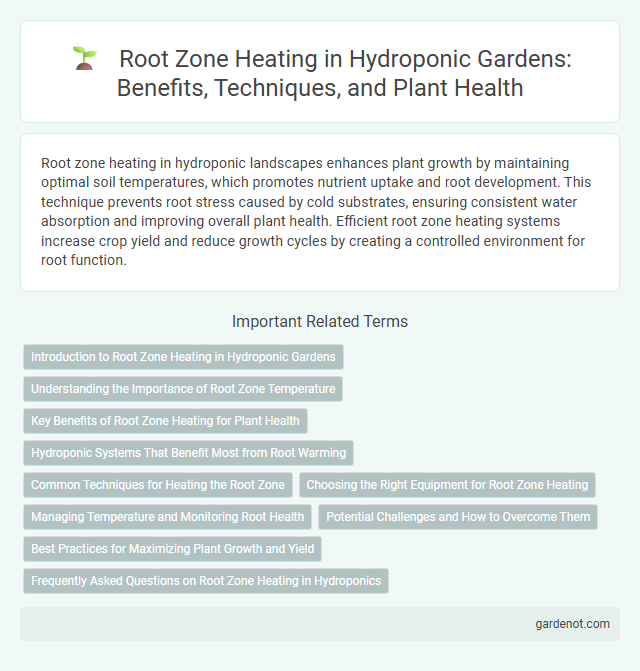Root zone heating in hydroponic landscapes enhances plant growth by maintaining optimal soil temperatures, which promotes nutrient uptake and root development. This technique prevents root stress caused by cold substrates, ensuring consistent water absorption and improving overall plant health. Efficient root zone heating systems increase crop yield and reduce growth cycles by creating a controlled environment for root function.
Introduction to Root Zone Heating in Hydroponic Gardens
Root zone heating in hydroponic gardens involves warming the nutrient solution or growing medium directly around plant roots to enhance nutrient uptake and promote faster growth. Maintaining optimal root temperatures between 20-25degC boosts metabolic activity and prevents root stress caused by cold conditions. This technique increases crop yields and improves plant health by creating a stable root environment in otherwise cooler climates or seasons.
Understanding the Importance of Root Zone Temperature
Maintaining optimal root zone temperature is crucial for hydroponic landscapes as it directly influences nutrient uptake, root metabolism, and overall plant growth. Root zone heating systems regulate soil temperature, preventing root stress caused by cold conditions, thereby enhancing oxygen availability and microbial activity. Consistently stable root temperatures between 20-25degC maximize nutrient absorption efficiency and improve crop yield in hydroponic environments.
Key Benefits of Root Zone Heating for Plant Health
Root zone heating enhances plant health by maintaining optimal soil temperatures, which accelerates nutrient uptake and root development. This controlled warming reduces transplant shock and promotes faster germination and growth cycles in hydroponic systems. Consistent root zone temperature fosters resilient plants with improved resistance to diseases and environmental stress.
Hydroponic Systems That Benefit Most from Root Warming
Root zone heating significantly enhances plant growth in hydroponic systems such as nutrient film technique (NFT), deep water culture (DWC), and aeroponics by maintaining optimal root temperatures between 20-24degC. Systems with high water volume and continuous nutrient flow benefit most because consistent warmth improves nutrient uptake and root metabolism. Efficient root warming in hydroponic setups reduces chilling stress, increases oxygen availability at the root interface, and promotes faster crop cycles.
Common Techniques for Heating the Root Zone
Common techniques for root zone heating in hydroponic landscapes include using heated water circulation systems, electric heating cables, and thermal mats placed beneath the growing containers. Water circulation systems maintain consistent root temperatures by circulating warm nutrient solutions through pipes or tubes surrounding the root zone. Electric heating cables and thermal mats provide direct heat transfer to the substrate, promoting optimal root development and overall plant growth.
Choosing the Right Equipment for Root Zone Heating
Selecting the appropriate equipment for root zone heating in hydroponic landscapes hinges on factors such as crop type, grow volume, and energy efficiency. Options including electric heating cables, heated mats, and water-based systems offer varying temperature control precision and installation complexity. Prioritizing devices with accurate thermostatic regulation ensures optimal root zone temperatures, promoting healthier plant growth and maximizing yield.
Managing Temperature and Monitoring Root Health
Root zone heating is essential for managing optimal temperature in hydroponic landscapes, ensuring consistent warmth that promotes nutrient uptake and root development. Precise monitoring through temperature sensors allows for real-time adjustments, preventing stress and disease in the root zone. Maintaining stable root temperatures enhances overall plant health, growth rates, and crop yields in controlled environments.
Potential Challenges and How to Overcome Them
Root zone heating in hydroponic landscapes can cause challenges such as uneven temperature distribution, leading to root stress and nutrient uptake issues. To overcome these challenges, implementing precise temperature monitoring with thermostats and ensuring uniform heat dispersion using heated mats or cables are essential. Regular maintenance and adjustments based on plant species' optimal root zone temperatures help prevent thermal damage and promote healthy growth.
Best Practices for Maximizing Plant Growth and Yield
Maintaining an optimal root zone temperature between 20-25degC is critical for maximizing plant growth and yield in hydroponic systems. Employing insulated heating cables and thermostatically controlled root zone heaters ensures stable thermal conditions that enhance nutrient uptake and root metabolism. Regular monitoring with soil sensors and adjusting heating based on plant species-specific requirements prevent root stress and promote vigorous development.
Frequently Asked Questions on Root Zone Heating in Hydroponics
Root zone heating in hydroponics optimizes nutrient uptake and accelerates plant growth by maintaining ideal root temperatures between 65degF to 75degF, enhancing metabolic activity and oxygen absorption. Common questions address the best heating methods, such as using heating mats or insulated pipes, and managing energy costs without overheating the roots. Proper installation and monitoring can prevent root diseases and ensure consistent crop yields in controlled environment agriculture.
Root zone heating Infographic

 gardenot.com
gardenot.com